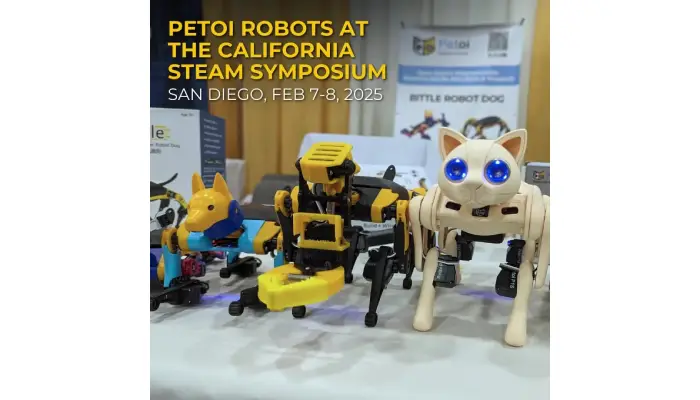Meet the Latest in Mechanical Dogs: A Comprehensive Guide to Robotic Canines in 2025
By 2025, robotic dogs are advancing with AI, offering natural movements and applications in security and healthcare, promising companionship and smart home integration.

Robotic dogs, also known as mechanical canines, have made impressive strides by 2025. These innovations blend advanced AI and machine learning for an interactive experience, allowing them to learn from their surroundings and follow commands with surprising accuracy. Their movements are becoming more natural, making it possible for them to run and jump just like real dogs. Equipped with state-of-the-art sensors, they can recognize people and react to various stimuli. With applications ranging from security patrols to providing companionship in healthcare settings.
Understanding Robotic Dogs in 2025
Robotic dogs, or mechanical canines, have come a long way in 2025. Designed to mimic real dogs in appearance and behavior, these innovations showcase impressive advancements in technology. The integration of artificial intelligence and machine learning allows them to learn and adapt, making interactions feel more natural. With fluid movements, they can run, jump, and navigate various terrains, resembling the agility of real canines. Equipped with sophisticated sensory technology, including cameras and microphones, these robotic companions can recognize people and respond to their environment.\
Their applications are diverse, from enhancing security in various sectors to providing companionship in healthcare settings. Looking ahead, we can expect even more interactivity and integration into smart home systems, along with a focus on eco-friendly designs. The evolution of robotic dogs reflects a blend of technology and companionship, paving the way for new possibilities in everyday life.
Innovative Features of Mechanical Canines
Mechanical canines in 2025 boast a range of innovative features that enhance their functionality and user experience. A standout aspect is their integration of advanced AI and machine learning, allowing these robotic dogs to learn from their surroundings and respond to human commands. This capability makes them more interactive, as they can adapt to various scenarios, providing a personalized experience for users.
Realistic movement is another significant advancement. Thanks to improvements in robotics technology, mechanical canines can move fluidly, mimicking the agility of real dogs. They can run, jump, and navigate complex terrains, making them not just toys but functional companions that can keep up with the pace of life.
Sensory technology plays a crucial role in enhancing their capabilities. Equipped with cameras, microphones, and LIDAR, these robotic dogs can perceive their environment, recognize familiar faces, and interact with objects. This sensory perception allows them to engage more meaningfully with humans and their surroundings, whether they’re providing companionship or assisting in more serious tasks.
The applications of these features are vast. In security and surveillance, robotic dogs patrol areas and monitor events, significantly reducing risks to human security personnel. In healthcare settings, they offer companionship and emotional support to patients, especially the elderly, proving to be more than just machines. In search and rescue operations, their ability to navigate rubble and hazardous environments makes them invaluable in locating survivors after disasters.
Overall, the innovative features of mechanical canines not only make them more capable but also deepen their role in various sectors, highlighting the future potential of robotic companions.
- Autonomous navigation capabilities
- Ability to perform complex tasks
- Customizable appearances and functions
- Integrated AI for learning and adaptation
- Remote operation via smartphone apps
- Multi-environment adaptability
- Real-time feedback and communication
AI and Learning in Robotic Dogs
Robotic dogs in 2025 showcase impressive advancements in artificial intelligence and machine learning, allowing them to learn from their surroundings and improve their interactions. They can respond to human commands, understand gestures, and adapt their behavior based on past experiences. For instance, a robotic dog might learn to recognize its owner’s voice and respond more quickly to commands over time.
These canines utilize sophisticated algorithms to analyze data from their sensors, enabling them to navigate complex environments. This capability is enhanced by improvements in their movement mechanics, allowing them to run, jump, and even perform tricks like real dogs. As they gather data about their surroundings, they become increasingly adept at making decisions in real-time, whether it’s avoiding obstacles or engaging with people.
Moreover, the integration of AI facilitates emotional responses, making robotic dogs more relatable companions. They can recognize human emotions through vocal tones and facial expressions, adjusting their behavior to provide comfort or companionship when needed. This is particularly valuable in therapeutic settings, where robotic dogs can help alleviate feelings of loneliness or anxiety in patients. Overall, the fusion of AI and learning in robotic dogs not only enhances their functionality but also creates a deeper bond with users.
Realistic Movement and Navigation
In 2025, robotic dogs have made significant strides in their ability to move and navigate. These mechanical canines are designed to mimic the fluid motions of real dogs, allowing them to run, jump, and traverse various terrains with ease. This advancement is largely due to breakthroughs in robotics technology, which enable these machines to maintain balance and agility, even on uneven surfaces or obstacles.
The integration of advanced AI and machine learning enhances their movement capabilities by allowing them to learn from their surroundings. This means they can adjust their paths in real-time, avoiding obstacles and optimizing routes. Equipped with an array of sensors, like cameras and LIDAR, they can perceive and interpret their environment, which is crucial for tasks ranging from security patrols to search and rescue missions.
Moreover, these robotic dogs are being designed to respond to human commands and cues, making their interactions feel more natural. Their navigation systems are becoming increasingly sophisticated, with the ability to map out areas and navigate autonomously. This level of realism not only adds to their functionality but also makes them more relatable to users, blurring the line between technology and companionship.
Advanced Sensory Technology
In 2025, the sensory technology in robotic dogs has reached impressive levels, allowing these mechanical companions to interact with the world in ways that were once thought impossible. With a variety of sensors like cameras, microphones, and LIDAR, these robotic canines can perceive their environment much like real dogs. For example, they can recognize familiar faces, respond to sounds, and navigate complex terrains with ease. This advanced sensory capability not only enhances their functionality but also makes them more relatable to humans.
Consider how these features enable a robotic dog to assist in security operations. Imagine a robotic canine patrolling a facility. It can detect movement or unusual sounds, alerting human operators to potential threats while providing real-time video feeds from its cameras. In healthcare settings, sensory technology allows these dogs to sense when a patient is feeling anxious or in need of comfort, responding with companionship to ease their distress. The integration of these advanced sensors elevates the role of robotic dogs in various applications, making them invaluable tools in both professional and personal environments.
Robotic Dogs in Security Operations
Robotic dogs are transforming security operations in remarkable ways. With their advanced AI and machine learning capabilities, these mechanical canines can patrol areas and monitor events with precision, significantly reducing the risks faced by human security personnel. Equipped with high-definition cameras and thermal sensors, these robotic dogs can detect intrusions and alert human operators in real time. Moreover, their ability to adapt to different scenarios makes them invaluable in various security contexts, from corporate campuses to public events. As they continue to evolve, the role of robotic dogs in security will likely expand, enhancing safety and efficiency in monitoring operations.
Healthcare Applications of Robotic Canines
In the healthcare sector, robotic dogs are carving out a crucial role, particularly in enhancing patient well-being. These mechanical companions provide emotional support, which is vital for individuals in hospitals and long-term care facilities. For instance, studies have shown that interactions with robotic pets can reduce feelings of loneliness and anxiety among elderly patients. Equipped with advanced AI, these robotic canines can recognize faces and respond to emotional cues, making them more relatable and supportive. Moreover, their ability to engage in simple activities, like playing fetch or responding to commands, can stimulate cognitive function and physical activity in patients, especially those recovering from surgery or dealing with chronic conditions. The integration of robotic dogs into therapy programs demonstrates a forward-thinking approach to patient care, blending technology with compassion.
Search and Rescue Capabilities
In 2025, robotic dogs have become essential tools in search and rescue operations. Their ability to navigate through challenging terrains makes them invaluable in disaster scenarios like earthquakes or collapsed buildings. Equipped with advanced sensory technology, these robotic canines can detect heat signatures and sounds, allowing them to locate survivors trapped beneath rubble. Additionally, the integration of AI enables these machines to analyze real-time data, improving their efficiency in locating missing persons. As they continue to evolve, robotic dogs are set to play an even greater role in saving lives during crises.
Future Trends in Robotic Canines
As we look ahead, the field of robotic canines is poised for remarkable advancements. One significant trend is the push for enhanced interactivity. Future robotic dogs are expected to understand and respond to a wider range of voice commands and complex instructions, making them more engaging companions. Simultaneously, their integration into smart home ecosystems will become more seamless. These robotic canines will not only serve as playful pets but also interact with other Internet of Things (IoT) devices, enhancing home security and automation. Imagine a robotic dog that can alert you of unusual activity while syncing with your home security system.
Another vital trend is sustainability. Developers are increasingly focusing on eco-friendly materials and energy-efficient designs. This shift ensures that robotic dogs can be both innovative and responsible, appealing to environmentally-conscious consumers. For instance, future models may utilize biodegradable components or renewable energy sources, reducing their environmental footprint.
Overall, as we progress through 2025, robotic dogs are set to evolve into even more integral parts of our lives, blending advanced technology with the warmth of companionship.
Integrating Robotic Dogs into Smart Homes
As smart home technology continues to evolve, robotic dogs are finding their place as integral members of these ecosystems. By connecting with other Internet of Things (IoT) devices, they enhance home security and automation. For instance, a robotic dog can patrol the home and alert the owner if it detects unusual activity through its sensors. In this interconnected environment, robotic dogs can also communicate with smart cameras, lighting systems, and alarms, creating a comprehensive security network. Moreover, their ability to recognize family members allows them to interact uniquely with each individual, personalizing their responses and actions. Imagine a robotic canine that not only greets you at the door but can also adjust the thermostat or turn on the lights as you walk in. This seamless integration drives us closer to a future where our homes are not just smart but also responsive companions.
Sustainability in Robotic Dog Design
In 2025, sustainability has become a focal point in the design and manufacturing of robotic dogs. As technology advances, companies are increasingly prioritizing eco-friendly materials and energy-efficient systems. For example, many manufacturers are now using recyclable plastics and biodegradable components in their robotic canines, reducing the environmental impact of production.
Additionally, energy efficiency plays a crucial role. Robotic dogs are being designed with advanced batteries that not only extend their operational time but also minimize energy consumption. This shift not only lowers the carbon footprint but also makes these devices more accessible for everyday use.
Frequently Asked Questions
1. What kind of tasks can robotic dogs do in 2025?
In 2025, robotic dogs can help with various tasks like companionship, security, and even assisting people with disabilities. They may also be used for search and rescue missions, offering a wide range of support.
2. How do robotic dogs sense their environment?
Robotic dogs use sensors like cameras, microphones, and infrared detectors to understand their surroundings. This helps them navigate, avoid obstacles, and interact with people and objects.
3. Can you train a robotic dog like a real canine?
Yes, you can train robotic dogs using commands and programming. They often come with apps that allow you to set behaviors, so you can teach them tricks or commands similar to a real dog.
4. Are robotic dogs safe for kids and pets?
Most robotic dogs are designed with safety in mind, using soft materials and built-in sensors to prevent accidents. However, it’s always good to supervise interactions between robotic pets and younger children or other animals.
5. How do robotic dogs get their energy?
Robotic dogs are usually powered by rechargeable batteries. Depending on the model, they can run for several hours on a single charge, and they often have features that signal when they need to recharge.
Resource URL:
https://en.wikipedia.org/wiki/List_of_robotic_dogs
https://www.petoi.com/pages/bittle-x-open-source-voice-controlled-robot-dog

Lyle Vasquez is a technology blogger based in Connecticut. He has been passionate about technology since early childhood when he used to take apart and rebuild computers in his parent’s garage. Lyle’s tech-related blog posts are written to help others learn how to use the latest technology tools and devices. He loves to find new ways to integrate technology into everyday life. Lyle is a great resource for tech enthusiasts looking to stay up to date on the latest technologies.





